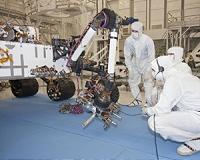 |
Flagstaff, Arizona (AFP) Sept 18, 2010 It may not have all the creature comforts, but Aaron Hulse considers his space exploration rover a pleasant home away from home. That is crucial as he and other NATO experts spend days together in the Arizona desert, simulating the arid surface of some distant planet or asteroid -- complete with a dormant volcano. "You just have to get comfortable with being close in here," Hulse said, speaking matter-of-factly about the seven days that he and a NASA colleague spent recently living in the rover's cramped quarters. "The seats fold down, and it's actually comfortable," said the 29-year-old, motioning to the living space behind him as he piloted the six-wheeled vehicle sideways and backwards over rough and rocky terrain. Hulse and a team of NASA engineers and scientists have worked many hours in the last two weeks in such maneuvers, putting the rover and other space vehicle prototypes through their paces. "It's quite nice," Hulse said. "When we have some extra time, we watch movies, we play games, we can do whatever kind of thing we want to do," he added bringing the bumpy ride to a halt. The NASA team has wrapped up its Desert RATS Analog mission, an intensive series of tests of new aerospace equipment and technology. This year marks the mission's thirteenth year, held at the Black Point Lava Flow test site in the northern Arizona desert. The Desert RATS project, short for Research and Technology Studies, is part of ongoing research by NASA to develop cutting-edge space technology for use in future manned deep space missions. The project allows the US space agency to bring its work out of the laboratory to be tested in the field, where the steep hills and the dust from dry river beds duplicates the harsh conditions on the Moon and other planets. "Coming out here allows us to really stress the systems," said Rob Ambrose, a project scientist. Ambrose and other RATS mission team members were eager to show off the new hardware, including advances they've achieved in Robotics technology. A "robonaut," or humanoid robot, developed by NASA will fly on a future space shuttle mission and assist crew members before the shuttle project is scrapped. "This is practice, in a very realistic environment," said Michael Gernhardt, a NASA astronaut who has flown on several space shuttle missions. "You need that reality," he said. "It's learning from that practice, that's what is important," he added, over the whine of a rover's motor as the vehicle neared the edge of a dry river bed. Gernhardt said the rovers had traversed over 150 kilometers (95 miles) in the past two weeks in the field, and had held up well on the difficult terrain, which includes several extinct volcanoes. The field mission included tests of a new exploration module for scientific research adaptable to habitats on distant planets or asteroids, equipment for compositional analysis of rock samples, and for medical emergencies in space. The NASA team also demonstrated advances in fuel cell systems efficiency and in communications technology. The rovers and other exploration vehicles tested can be operated remotely from the Johnson Space Center in Houston and other locations. Several university and corporate partners contributed research, and NASA is working to expand international collaboration, with future participation from the Canadian and European space agencies. Planners say they hope to include advanced robotics systems from the Canadian Space Agency in next year's mission. Desert RATS is part of larger NASA mission objectives in achieving its goal of expanding the role of the commercial sector in accessing low earth orbits and developing the international space station. The Obama administration has set new priorities for planetary exploration, and has called for a NASA mission to an asteroid by 2025.
Share This Article With Planet Earth
Related Links Mars News and Information at MarsDaily.com Lunar Dreams and more
 Strong Robotic Arm Extends From Next Mars Rover
Strong Robotic Arm Extends From Next Mars RoverPasadena CA (JPL) Sep 17, 2010 NASA's Mars rover Curiosity has been exercising its robotic arm since last month, when the arm was first fastened to the rover. In the long run, watch for this long and strong arm to become the signature apparatus of NASA's Mars Science Laboratory. After landing in August 2012, the mission will rely on it for repeated research activities. One set of moves crucial to the mission's success h ... read more |
|
| The content herein, unless otherwise known to be public domain, are Copyright 1995-2010 - SpaceDaily. AFP and UPI Wire Stories are copyright Agence France-Presse and United Press International. ESA Portal Reports are copyright European Space Agency. All NASA sourced material is public domain. Additional copyrights may apply in whole or part to other bona fide parties. Advertising does not imply endorsement,agreement or approval of any opinions, statements or information provided by SpaceDaily on any Web page published or hosted by SpaceDaily. Privacy Statement |